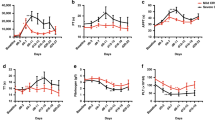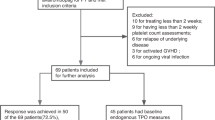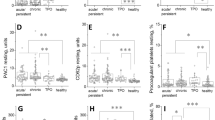Summary:
We assessed the effect of rabbit antithymocyte globulin manufactured by Fresenius (ATG-F) on the hemostatic system in patients (n=12) with various hematological malignancies undergoing hematopoietic stem cell transplantation (HSCT) from HLA-matched unrelated donors. For this purpose, we monitored different parameters of coagulation before, during and after the administration of ATG-F. As a control group, we recruited patients (n=10) undergoing HSCT from their HLA-identical siblings who did not receive ATG-F as part of their preparative regimens. At 24 and 48 h after ATG-F treatment had been initiated, we found a temporary rise in D-Dimer, tissue factor, soluble thrombomodulin and thrombin-antithrombin III complex levels and a significant decrease of platelet counts in patients treated with ATG-F as compared to the control group. No differences between the two groups could be detected with regard to global coagulation tests as well as the incidence of bleeding manifestations, thromboembolic complications or the development of vascular-occlusive-disease of the liver. This temporary state of a stressed but compensated coagulation system under ATG-F therapy can be addressed as nonovert disseminated intravascular coagulation (DIC). The effect was independent from the different conditioning regimens and eased off after cessation of ATG-F. We conclude that ATG-F can induce nonovert DIC in patients receiving antithymocyte globulin as part of their conditioning regimen for HSCT.
This is a preview of subscription content, access via your institution
Access options
Subscribe to this journal
Receive 12 print issues and online access
$259.00 per year
only $21.58 per issue
Buy this article
- Purchase on Springer Link
- Instant access to full article PDF
Prices may be subject to local taxes which are calculated during checkout



Similar content being viewed by others
References
Kröger N, Zabelina T, Krüger W et al. Anti-thymocyte globulin as part of the preparative regimen prevents acute and chronic graft-versus-host-disease (GVHD) in allogeneic stem cell transplantation from unrelated donors. Ann Hematol 2001; 80: 209–215.
Finke N, Bertz H, Schmoor C et al. Allogeneic bone marrow transplantation from unrelated donors using in vivo anti T cell globulin. Br J Haematol 2000; 11: 303–313.
Zander AR, Zabelina T, Kröger N et al. Use of a five agent GVHD prevention regimen in recipients of unrelated donor marrow. Bone Marrow Transplant 1999; 23: 889–893.
Kröger N, Zabelina T, Krüger W et al. In vivo T cell depletion with pretransplant anti-thymocyte globulin reduces graft-versus-host disease without increasing relapse in good risk myeloid leukemia patients after stem cell transplantation from matched related donors. Bone Marrow Transplant 2002; 29: 683–689.
Remberger M, Svahn BM, Hentschke P et al. Effect on cytokine release and graft-versus-host disease of different anti-T cell antibodies during conditioning for unrelated haematopoeitic stem cell transplantation. Bone Marrow Transplant 1999; 24: 823–830.
Wechter WJ, Brodie J, Morrel RM et al. Antithymocyte globulin (ATGAM) in renal allograft recepients. Transplantation 1979; 28: 294–302.
Cosimi AB . The clinical value of antithymocyte antibodies. Transplant Proc 1981; 13: 462–468.
Kimball D, Rickles F, Gockermann JP et al. Procoagulant and platelet aggregation properties of antilymphocyte sera. J Lab Clin Med 1976; 5: 868–881.
Henricsson A, Hedner U, Bergentz SE et al. The effect of ALG on coagulation and fibrinolysis. Thromb Res 12: 1099–1112.
Fischer M, Lechner K, Hinterberger W et al. Deficiency of fibrinogen and factor VII following treatment of severe aplastic anaemia with anti-thymocyte globulin and high dose methylprednisolone. Scand J Haematol 1985; 34: 312–316.
Goldmann MH, McGrath G, Freemann S et al. D-Dimer XDP correlates with fibrinolytic shutdown in renal transplant patients treated with anti-T cell antibodies. Transplant Proc 1995; 27: 1094–1096.
Trivedi HS, Lal SM, Gupta N et al. ATGAM associated coagulopathy in renal transplant patients: a report of two unusual cases. Int J Art Organs 1996; 19: 448–450.
Pihusch R, Holler E, Muehlbayer D et al. The impact of antithymocyte globulin on short-term toxicity after allogeneic stem cell transplantation. Bone Marrow Transplant 2002; 30: 347–354.
Titiz MI, Turkmen F, Yegenaga I et al. Abdominal pain that mimics acute appendicitis caused by an ATG overdose in a kidney transplant recipient. Transplant Int 1994; 7: 385.
Dalton RG, Davison AM, Gader AM et al. Antilymphocyte globulin administration does not appear to cause diffuse intravascular coagulation. Eur Surg Res 1974; 5: 315–320.
Shield CF, Cosimi AB, Tolkoff-Rubin N et al. Use of antilymphocyte globulin for reversal of acute allograft rejection. Transplantation 1979; 28: 461–464.
Catani L, Gugliotta M, Mattioli BN et al. Hypercoagulability in patients undergoing autologus or allogeneic BMT for hematological malignancies. Bone Marrow Transplant 1993; 12: 253–259.
Nürnberger W, Michelmann I, Burdach S et al. Endothelial dysfunction after bone marrow transplantation: increase of soluble thrombomodulin and PAI-1 in patients with multiple transplant-related complications. Ann Hematol 1998; 76: 61–65.
Salat C, Holler E, Kolb HJ et al. Endothelial cell markers in bone marrow tranplantation in recipients with and without acute graft-versus-host disease. Bone Marrow Transplant 1997; 19: 909–914.
Carreras E . Veno-occlusive disease of the liver after hemopoietic cell transplantation. Eur J Haematol 2000; 64: 281–291.
Villalon L, Avello AG, Cesar J et al. Is veno-occlusive disease a specific syndrome or the exacerbation of physiopathologic hemostatic changes in hematopoietic stem cell transplantation (HSCT)? Thromb Res 2000; 5: 439–446.
Vannucchi AM, Rafenelli D, Longo G et al. Early hemostatic alterations following bone marrow transplantation: a prospective study. Haematologica 1994; 79: 519–525.
Srivastava A, Gottlieb D, Bradstock KF . Diffuse alveolar haemorrhage associated with microangiopathy after allogeneic bone marrow transplantation. Bone Marrow Transplant 1995; 6: 863–867.
Fuge R, Bird JM, Fraser A et al. The clinical features, risk factors and outcome of thrombotic thrombocytopenic purpura occuring after bone marrow transplantation. Br J Haematol 2000; 113: 58–64.
Taylor Jr FB, Toh CH, Hoots WK et al. Towards definition, clinical and laboratory criteria, and a scoring system for disseminated intravascular coagulation. Thromb Haemostasis 2001; 5: 1327–1330.
Osterud B . Tissue factor: a complex biological role. Thromb Haemostasis 1997; 1: 755–758.
Barstad RM, Hamers MJ, Kierulf P et al. Procoagulant human monocytes mediate tissue factor/factor VIIa-dependent platelet thrombus formation when exposed to flowing nonanticoagulated human blood. Arterioscler Thromb Vasc Biol 1995; 15: 11–16.
Monaco C, Andreaka E, Young S et al. T-cell mediated signaling to vascular endothelium: induction of cytokines, chemokines, and tissue factor. J Leuk Biol 2002; 4: 659–668.
Levi M, ten Cate H, van der Poll T . Endothelium: interface between coagulation and inflammation. Crit Care Med 2002; 5 (Suppl): S220–S224.
Pearson JD . Markers of endothelial perturbation and damage. Br J Rheumatol 1993; 32: 651–652.
Siddiqui FA, Desai H, Amirkhosravi A et al. The presence and release of tissue factor from human platelets. Platelets 2002; 4: 247–253.
Sabatier F, Roux V, Anfosso F et al. Interaction of endothelial microparticles with monocytic cells in vitro induces tissue factor-dependent procoagulant activity. Blood 2002; 11: 3962–3970.
Osterud B . The role of platelets in decrypting monocyte tissue factor. Semin Hematol 2001; 4 (Suppl. 12): 2–5.
Acknowledgements
We thank the staff of the BMT unit for providing excellent care of our patients and B Spath for her excellent technical assistance in the laboratory.
Author information
Authors and Affiliations
Rights and permissions
About this article
Cite this article
Weber, M., Kröger, N., Langer, F. et al. Non-overt disseminated intravascular coagulation in patients during treatment with antithymocyte globulin for unrelated allogeneic hematopoietic stem cell transplantation. Bone Marrow Transplant 31, 817–822 (2003). https://doi.org/10.1038/sj.bmt.1703921
Received:
Accepted:
Published:
Issue Date:
DOI: https://doi.org/10.1038/sj.bmt.1703921
Keywords
This article is cited by
-
Net reclassification improvement with serial biomarkers and bed-sided spirometry to early predict the need of organ support during the early post-transplantation in-hospital stay in allogeneic HCT recipients
Bone Marrow Transplantation (2019)
-
Anti-thymocyte globulin-induced hyperbilirubinemia in patients with myelofibrosis undergoing allogeneic hematopoietic cell transplantation
Annals of Hematology (2016)
-
Early thrombin generation and impaired fibrinolysis after SCT associate with acute GVHD
Bone Marrow Transplantation (2010)
-
Hepatotoxicity induced by horse ATG and reversed by rabbit ATG: a case report
Journal of Medical Case Reports (2007)
-
Assessment of the coagulation profile in hemato-oncological patients receiving ATG-based conditioning treatment for allogeneic stem cell transplantation
Bone Marrow Transplantation (2004)



